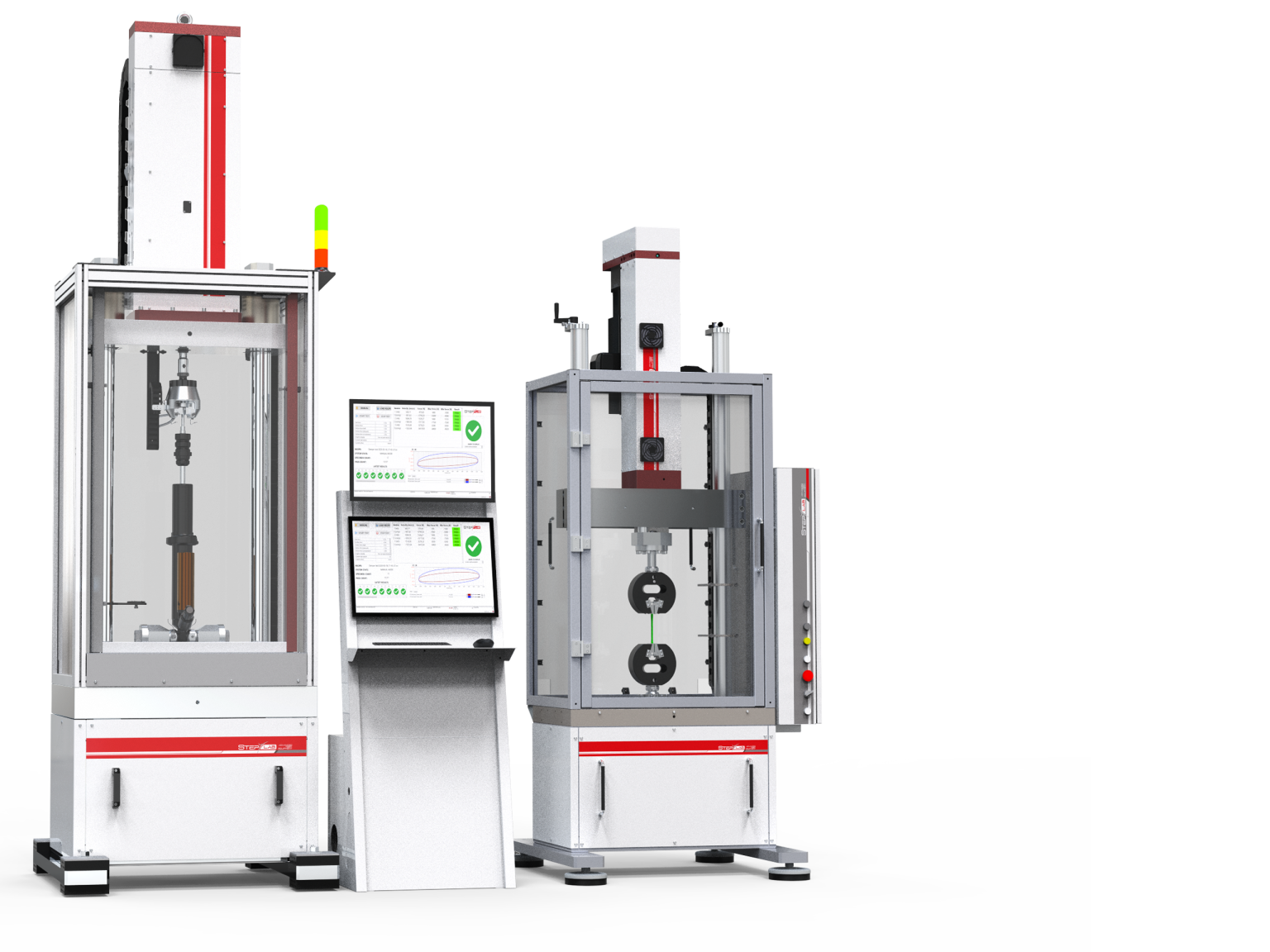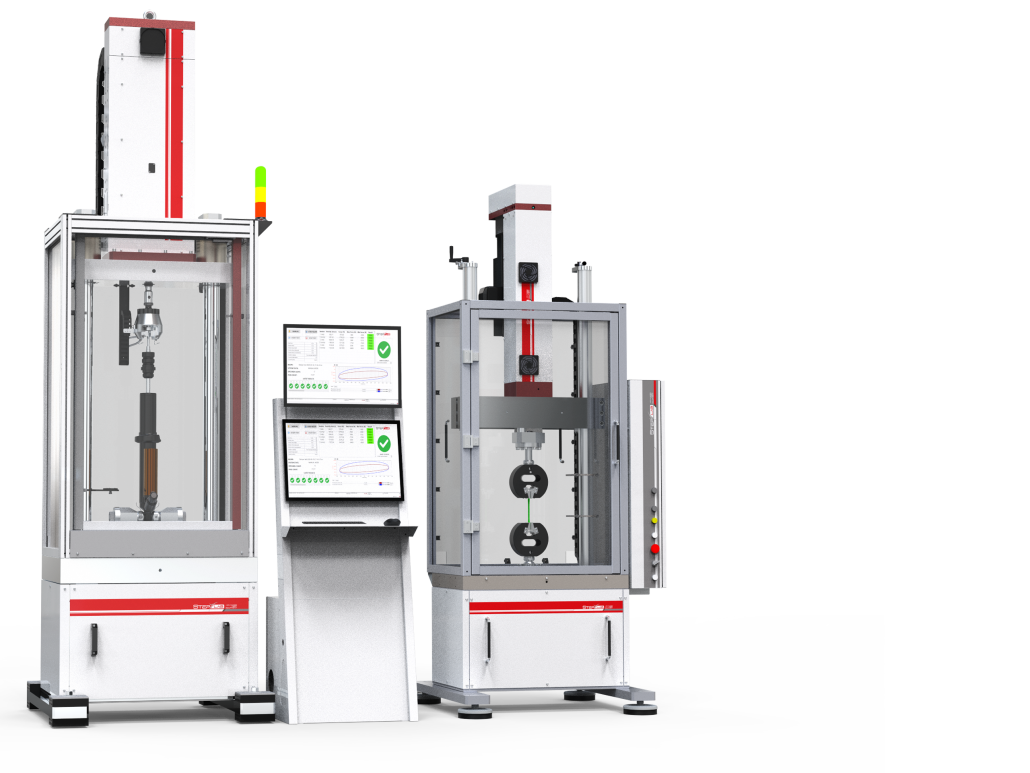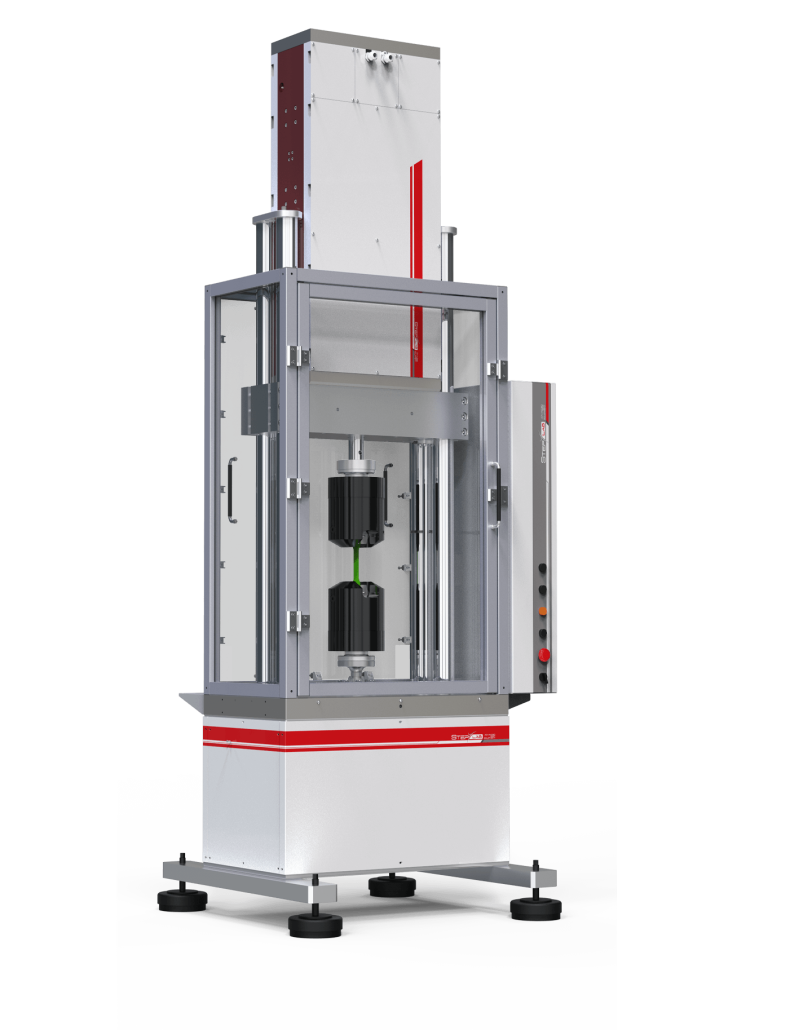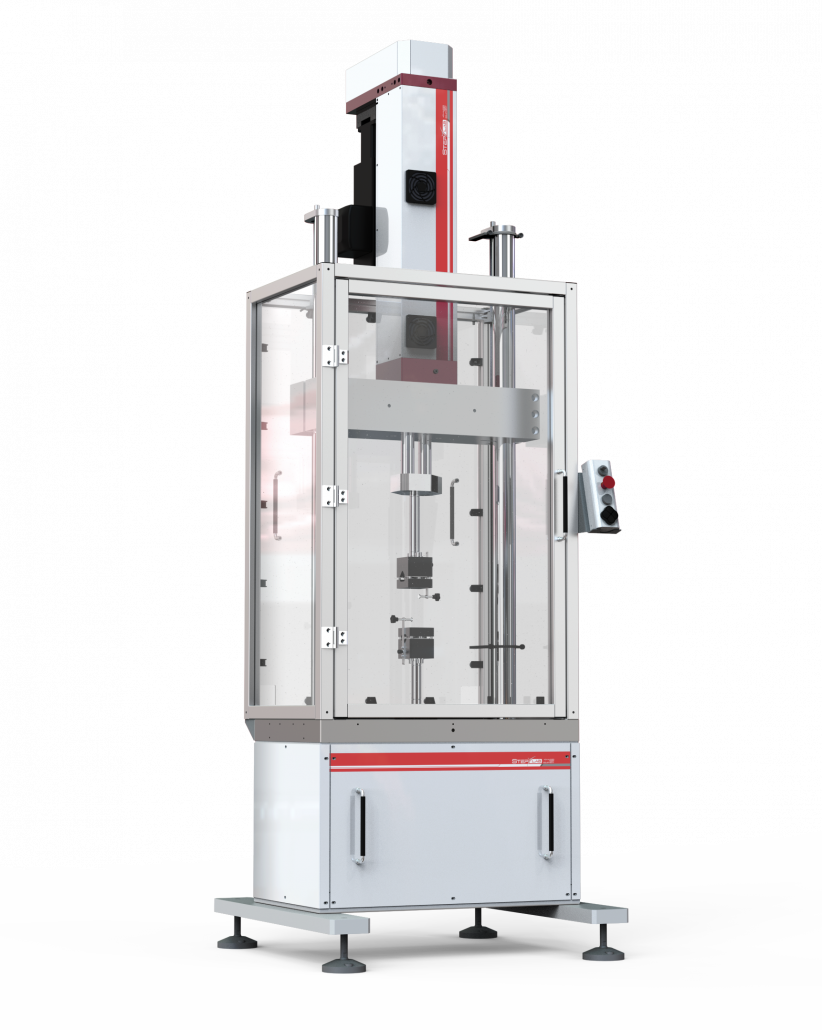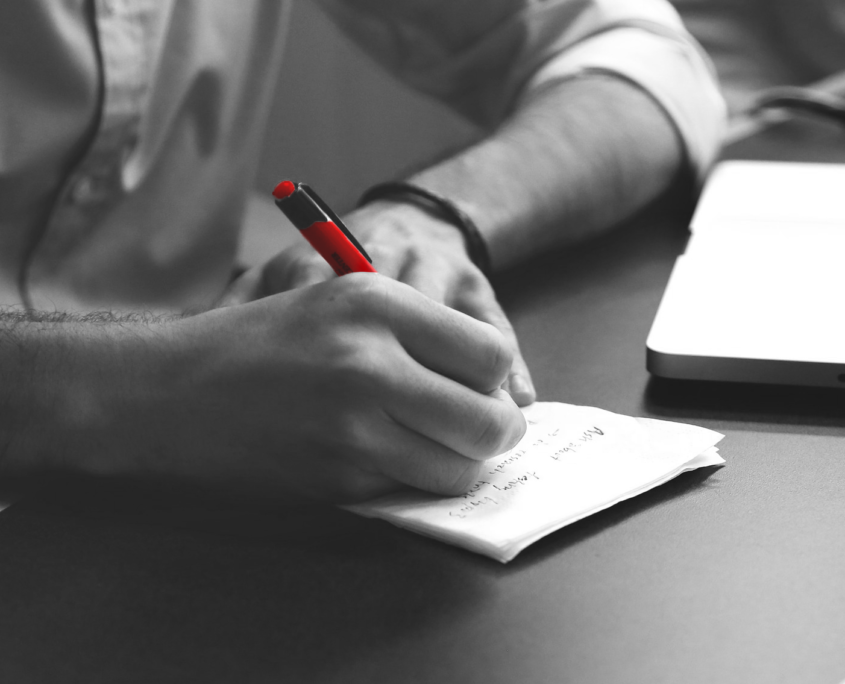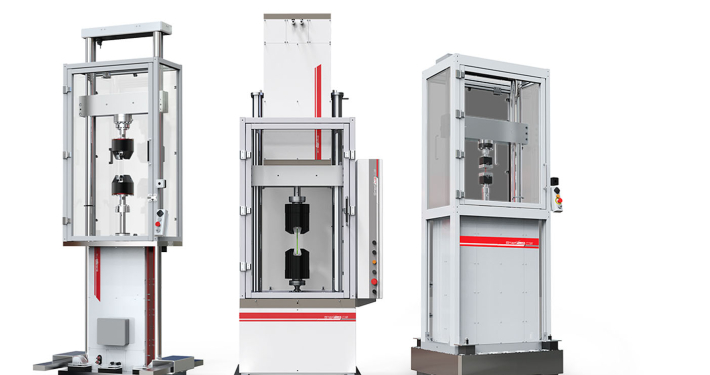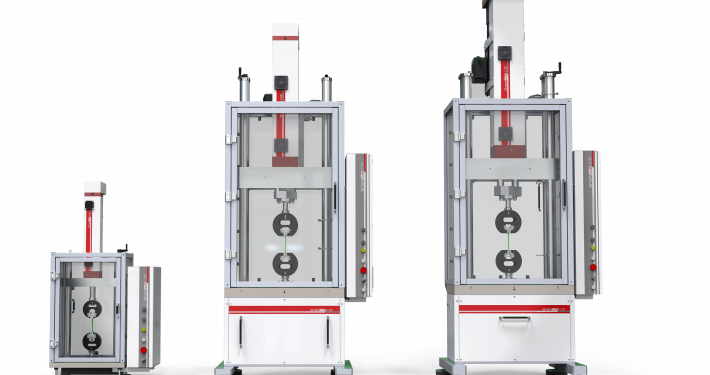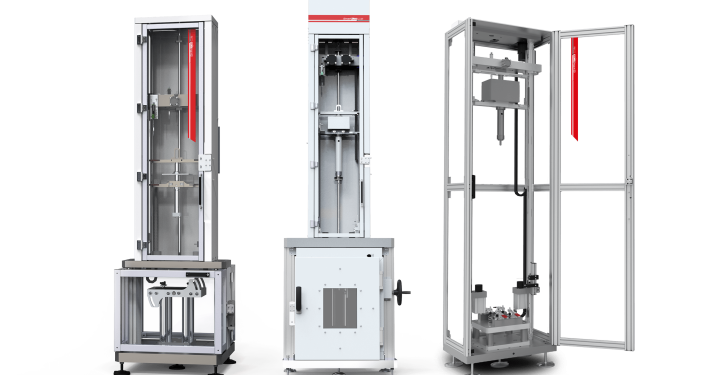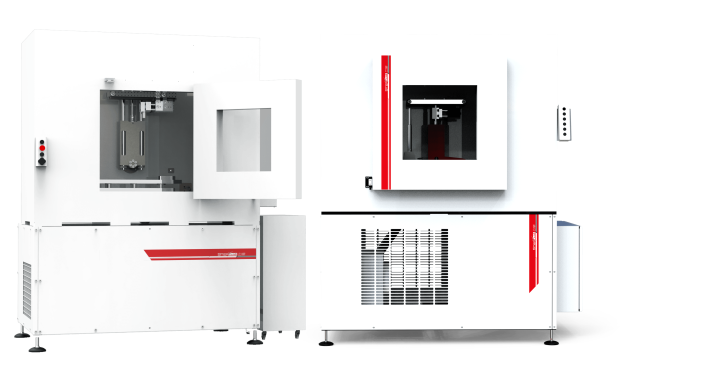动态和疲劳试验机
拉伸和压缩
在 STEP 实验室,我们专门设计和生产先进的动态测试系统,该系统经过优化,可进行拉伸、压缩、弯曲、剥离、剪切、摩擦和许多其他测试。 我们的设备符合 ASTM、ISO 和其他行业标准,性能卓越,可确保在各种应用中获得可靠、准确的结果。
动态测试系统
我们擅长设计和建造基于直线电机和机电致动器的动态测试系统。 我们的机器种类繁多,包括用于动态和疲劳试验的机型,最大承载能力可达 200 kN。 我们先进的解决方案涵盖各种应用和行业,可满足各种材料和产品测试要求。
基于直线电机的系统
我们基于线性电机的电动推杆可达到数十 g 的加速度、500 Hz 的频率和 100 kN 的连续载荷,峰值可达 120 kN。
机电系统
机电执行器适用于加速度高达 2g 和动态载荷高达 200kN 的测试,是多执行器应用的多功能执行器。
可执行的机械测试
- 高低循环疲劳测试
- 热机械疲劳测试
- 裂纹扩展和生长研究
- 断裂强度测试
- 双轴测试
- 轴扭转、多轴测试
- 高应变速率试验
- 准静态试验
- 蠕变试验
特点
标准
生物医学
| 证明 | 材料 | 诺尔玛 | 说明 |
| 静态/疲劳 | 生物医学 | ASTM F1264 | 髓内固定装置的标准规格和测试方法 |
| 静态/疲劳 | 生物医学 | ASTM F1717 | 椎体切除模型中脊柱植入结构的标准测试方法 |
| 静态/疲劳 | 生物医学 | ASTM F1798 | 评估脊柱关节植入物所用互连机构和组件的静态和疲劳特性的标准测试方法 |
| 静态/疲劳 | 生物医学 | ASTM F1800 | 全膝关节假体胫骨平台金属组件循环疲劳测试标准操作规程 |
| 静态/疲劳 | 生物医学 | ASTM F2068 | 股骨假体的标准规格–金属植入物 |
| 静态/疲劳 | 生物医学 | ASTM F2077 | 椎体间融合器的测试方法 |
| 静态/疲劳 | 生物医学 | ASTM F2193 | 脊柱骨骼系统手术固定所用组件的标准规格和测试方法 |
| 静态/疲劳 | 生物医学 | ASTM F2502 | 用于内固定植入物的可吸收钢板和螺钉的标准规格和测试方法 |
| 静态/疲劳 | 生物医学 | ASTM F2580 | 评估股骨近端固定髋关节假体模块连接的标准做法 |
| 静态/疲劳 | 生物医学 | ASTM F2706 | 椎体切除术模型中枕颈和枕颈胸椎植入体结构的标准测试方法 |
| 静态/疲劳 | 生物医学 | ASTM F382 | 金属骨板的标准规格和测试方法 |
| 静态/疲劳 | 生物医学 | ASTM F384 | 用于矫形骨折固定的成角金属装置的标准规格和测试方法 |
| 静态/疲劳 | 生物医学 | ASTM F543 | 金属医用骨螺钉的标准规格和测试方法 |
| 静态/疲劳 | 生物医学 | EN 843-1 | 整体陶瓷在室温下的机械性能 – 抗折强度的测定 |
| 静态/疲劳 | 生物医学 | ISO 11405 | 牙齿结构附着力测试 |
| 静态/疲劳 | 生物医学 | ISO 12189-8 | 脊柱植入装置的机械测试 – 使用前部支撑的脊柱植入组件的疲劳测试方法 |
| 静态/疲劳 | 生物医学 | ISO 14801 | 牙科 – 种植体 – 骨内牙科种植体的动态负荷测试 |
| 静态/疲劳 | 生物医学 | ISO 14879-1 | 全膝关节置换术 膝关节胫骨托强度特性测定 |
| 静态/疲劳 | 生物医学 | ISO 6872 | 牙科 – 陶瓷材料 |
| 静态/疲劳 | 生物医学 | ISO 7206 | 手术植入物 – 部分和全部髋关节置换术 |
| 静态/疲劳 | 生物医学 | ISO 9585 | 外科植入物 – 确定骨板的抗弯强度和刚度 |
自行车
| 证明 | 材料 | 诺尔玛 | 说明 |
| 静态/疲劳 | 自行车 | EN 15194 | 电动助力脚踏车 – EPAC 自行车 – 测试方法 |
| 静态/疲劳 | 自行车 | ISO 4210-3 | 自行车安全要求–第 3 部分:通用测试方法 |
| 静态/疲劳 | 自行车 | ISO 4210-4 | 自行车安全要求–第 4 部分:制动测试方法 |
| 静态/疲劳 | 自行车 | ISO 4210-5 | 自行车安全要求–第 5 部分:转向测试方法 |
| 静态/疲劳 | 自行车 | ISO 4210-6 | 自行车安全要求–第 6 部分:车架和前叉的测试方法 |
| 静态/疲劳 | 自行车 | ISO 4210-7 | 自行车安全要求–第 7 部分:车轮和轮辋的测试方法 |
| 静态/疲劳 | 自行车 | ISO 4210-8 | 自行车安全要求–第 8 部分:踏板和驱动系统测试方法 |
| 静态/疲劳 | 自行车 | ISO 4210-9 | 自行车安全要求–第 9 部分:鞍座和座管的测试方法 |
| 证明 | 材料 | 诺尔玛 | 说明 |
| 影响 | 自行车 | JIS D 9431 | 自行车鞍座冲击测试 |
| Vare | 自行车 | UCI | 自行车验证测试 |
金属
| 证明 | 材料 | 诺尔玛 | 说明 |
| 疲劳试验 | 金属 | ASTM A370 | 钢铁产品机械测试的测试方法和定义 |
| 疲劳试验 | 金属 | ASTM E3 | 金相样品制备指南 |
| 疲劳试验 | 金属 | ASTM E4 | 机器强度测试方法 |
| 疲劳试验 | 金属 | ASTM E8/E8M | 金属材料拉伸测试方法 |
| 疲劳试验 | 金属 | ASTM E9 | 室温下金属材料压缩试验方法 |
| 疲劳试验 | 金属 | ASTM E83 | 应变计系统的验证方法和分类 |
| 疲劳试验 | 金属 | ASTM E111 | 杨氏模量、切向模量和弦向模量的测试方法 |
| 疲劳试验 | 金属 | ASTM E112 | 确定平均粒度的测试方法 |
| 疲劳试验 | 金属 | ASTM E132 | 室温下泊松比的测试方法 |
| 疲劳试验 | 金属 | ASTM E177 | ASTM 测试方法中精度和极化术语的使用规范 |
| 断裂力学 | 金属 | ASTM E1457 | 测量金属中蠕变裂纹的生长时间 |
| 断裂力学 | 金属 | ASTM E647 | 测量疲劳裂纹的增长速度 |
| 断裂力学 | 金属 | ISO 11782-2 | 金属和合金的腐蚀–腐蚀疲劳试验:使用预裂纹试样进行裂纹扩展试验 |
| 断裂力学 | 金属 | ISO 12108 | 金属材料 – 疲劳试验 – 疲劳裂纹增长法 |
| 断裂力学 | 金属 | ASTM E647 | 测量疲劳裂纹增长速率的标准测试方法 |
| 断裂力学 | 金属 | ISO 7539-6 | 金属和合金的腐蚀 – 应力腐蚀试验 |
| 断裂力学 | 金属 | ASTM E399 | 金属材料线弹性平面拉伸断裂韧性标准测试法 |
| 断裂力学 | 金属 | ASTM E1820-11 | 测量断裂韧性(金属)的标准测试方法 |
| 蠕变 | 金属 | ASTM E139 | 进行金属材料的蠕变、蠕变破坏和应力破坏试验 |
| 蠕变 | 金属 | ISO 204 | 单轴活蠕变试验 |
| LCF | 金属 | ASTM E606 | 应变控制疲劳试验 |
| 影响 | 金属 | ASTM E208 SEP 1325 |
通过重量跌落试验确定铁素体钢的非韧性转变温度 (佩利尼试验) |
| 影响 | 金属 | ASTM E23 | 金属材料缺口棒的冲击试验 |
| 影响 | 金属 | ASTM E436 | 铁素体钢的跌落撕裂试验 |
| 影响 | 金属 | ISO 10274 | 落锤撕裂试验 |
| 影响 | 金属 | ISO 148-1 ISO 148-2 |
夏比冲击试验 |
| 静态测试 | 金属 | ASTM E21 | 金属材料的高温拉伸试验 |
| 静态测试 | 金属 | ASTM E290 | 材料延展性弯曲试验 |
| 静态测试 | 金属 | ASTM E517 | 金属板的塑性变形率 |
| 静态测试 | 金属 | ASTM E646 | 金属板材的拉伸硬化指数(n 值) |
| 静态测试 | 金属 | ASTM E8M | 金属材料拉伸试验 |
| 静态测试 | 金属 | ASTM E9 | 室温下的金属材料压缩测试 |
| 静态测试 | 金属 | EN 10002-1:2001(由 ISO EN 6892-1:2019 取代) | 金属材料拉伸试验 室温下的测试方法 |
| 静态测试 | 金属 | ISO 6892-1 | 金属材料 – 拉伸试验 第 1 部分:室温下的试验方法 |
| 静态测试 | 金属 | ISO 7438 | 金属材料。 折叠证明。 |
| 静态测试 | 金属 | ISO 783 | 金属材料 – 钢在高温下的拉伸试验 |
| 双轴平面 | 金属 | ISO 16842 | 十字形试样双轴拉伸试验方法 |
| LCF | 金属 | ASTM E606 | 应变控制疲劳试验 |
塑料
| 证明 | 材料 | 诺尔玛 | 说明 |
| 影响 | 塑料 | ASTM D1709 | 用自由落体飞镖法测定塑料薄膜的抗冲击性 |
| 影响 | 塑料 | ASTM D3763 | 利用载荷和位移传感器测量塑料的高速钻孔性能 |
| 影响 | 塑料 | ASTM D5420 | 硬质塑料扁平试样受到重物下落时一个点的冲击阻力(加德纳冲击力) |
| 影响 | 塑料 | ISO 13802 | 夏比、伊佐德和拉伸试验 |
| 影响 | 塑料 | ISO 148 | 夏比冲击试验 |
| 影响 | 塑料 | ISO 179-1 ISO 179-2 |
夏比冲击特性的测定 |
| 影响 | 塑料 | ISO 6603-1 ISO 6603-2 |
确定硬质塑料的穿孔冲击性能 |
| 影响 | 塑料 | ISO 7765-1 ISO 7765-2 BS 2782-3 |
塑料薄膜和箔 – 使用自由落体飞镖法测定冲击强度 |
| 证明 | 材料 | 诺尔玛 | 说明 |
| 静态测试 | 塑料 | ASTM D638 | 塑料的拉伸性能 |
| 静态测试 | 塑料 | ISO 527-1 ISO 527-2 |
塑料-拉伸性能测定 |
| 高应变率 | 塑料 | ISO 8256 | 拉伸冲击强度的测定 |
| 高应变率 | 塑料 | SAE J2749 | 聚合物的高速拉伸测试 |
组成
| 证明 | 材料 | 诺尔玛 | 说明 |
| 影响 | 复合材料 | EN 6038 | 冲击后抗压强度测定(CAI 试验) |
| 影响 | 复合材料 | ISO 18352 | 在特定冲击能量水平下测定冲击后的压缩特性(CAI 试验) |
| 影响 | 复合材料 | ASTM D7136/D7136M | 测量纤维增强聚合物基复合材料对落重冲击事件(冲击后压缩–CAI)的抗破坏性 |
橡胶
| 证明 | 材料 | 诺尔玛 | 说明 |
| 静态测试 | 橡胶 | ISO 2439 | 硬度测定(压痕技术) |
| 静态测试 | 橡胶 | ISO 3386 | 压缩应力应变特性的测定 |
| 证明 | 材料 | 诺尔玛 | 说明 |
| 疲劳试验 | 橡胶 | ISO 3385 | 通过恒定载荷下的锤击进行疲劳测定 |
| 证明 | 材料 | 诺尔玛 | 说明 |
| 橡胶测试 | 橡胶 | ASTM D3574 | 柔性蜂窝材料:粘合和模压聚氨酯泡沫塑料 |

